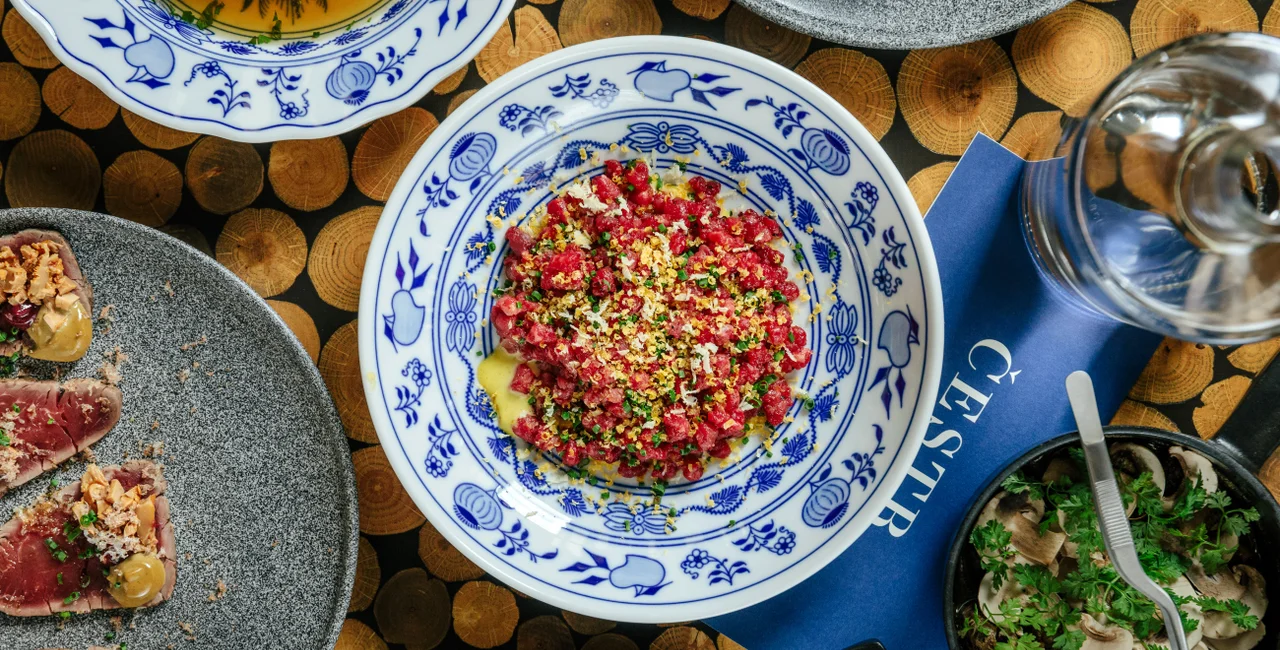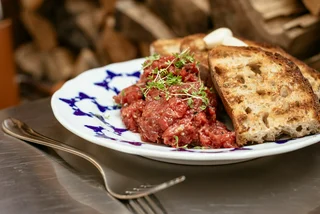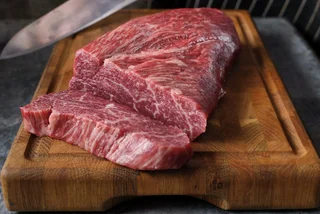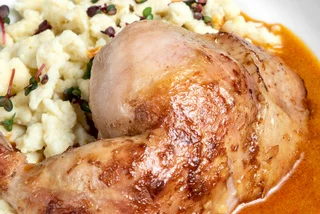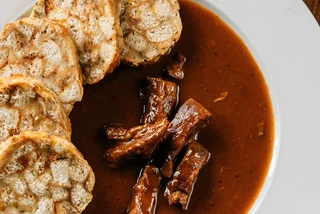Beef tartare (hovězí tatarák) may seem like one of the simplest dishes on the Czech menu and yet there are a multitude of ways to enhance it and some pitfalls to avoid during its home preparation. We asked Prague steakhouse Čestr’s head chef Pavel Brichzin to guide us through the process.
Once you're comfortable with the basics, you can experiment with innovative ingredients like beetroot, horseradish, and rye leaven (žitný kvásek) to create the same bold combination that has become one of the most popular items on Čestr’s menu.
French, American, or maybe Polynesian?
But first, a bit of history. Tatarák is another of the "Czech" dishes that may not have roots in Czech cuisine, despite being on every Czech pub menu. Tatarák with fried toast (s topinkou) is a popular beer pairing, and its recipe has many variations. Čestr’s version is more luxurious and requires slightly more preparation than others, but your taste buds will appreciate the effort that went into it.
Almost all gastronomic journeys lead to France, and tartar steak was in vogue in Paris at the turn of the 19th and 20th centuries, served with capers, egg yolk, and onions, and later with Dijon mustard. However, steak tartare (tatarský biftek) was first named Steak à l'Americaine by French chefs who liked to joke that Americans are barbarians who don't even know how to cook meat.
Eventually, the dish, which originally evolved from the French Polynesian tradition of eating raw meat, began to be served with mayonnaise instead of an egg yolk. But not just any mayonnaise. French chefs added pickles, garlic, shallots, and various spices to the mayonnaise served with the raw dish.
Putting a unique spin on steak tartare
Chef Brichzin said the original tatarák recipe has had its glory days and that "it was time to come up with another recipe using Czech ingredients” that showcases the Čestr team’s creativity. "While the original recipe involved pasteurized egg yolks, the new one replaces them with fresh eggs," he said.
Čestr‘s young kitchen team serves a new generation of tartare, which is coarsely minced or merely chopped and includes a couple of ingredients that take into account seasonal products. “We want to emphasize, among other things, the flavors that Czechia has to offer," Brichzin adds.
How to bring out the meat’s character
The beef rumps (hovězí kýta) selected for tatarák are cut and processed (staří a bourá) directly at Čestr. "We use the whole back quarter (of the beef rump) and after breaking it down we let it dry overnight for twelve hours. This allows excess juices to leave the meat, which is easily ground coarsely in the morning without turning into pâté. The drying also brings out the character of the beef," Brichzin explains.
He adds that the rump “gives the steak a perfectly fine texture, just like, for example, sirloin, which is not normally minced but cut into small pieces. Good meat then needs nothing more than good quality oil, salt, and smoked pepper."
Don’t be afraid to add beetroot and horseradish
Čestr’s regular guests are accustomed to tatarák which incorporates vegetables in various arrangements and consistencies. "Beef, beetroot and horseradish go beautifully together. We add the freshly roasted beetroot (freš z upečené) to the minced meat because it doesn't release as much earthiness as when juiced raw. It gives the tartar a specific taste and a rich, bloody color," says Brichzin. "In addition, we mix the beet juice with apple cider vinegar, pepper, and rapeseed oil."
The mix made from rye leaven and horseradish juice (žitného kvasu a křenové šťáv) is the first ingredient of the recipe. "Sufficiently fermented sourdough (prokvašený chlebový kvas) plays an important role. We have been feeding it for about two years now with rye flour from the family mill in Střížov," Brichzin says. "We whisk the sourdough starter with mayonnaise and horseradish juice until an emulsion is formed that gives the tatarák the desired acidity. In addition, we bake bread from it, and this bread is also used for topinek."
A few magic touches before serving
Before serving, tatarák is sprinkled with chives and dried egg yolk. "We brine the raw egg yolks in salt and sugar until the moisture evaporates and they get the texture of hard cheese. After some time, they are rinsed and left to dry in the sauna (v sauně)," Brichzin says. "Grated fresh horseradish is also on the plate; it pinches the nose and sharpens the taste of the tatarák instead of garlic."
Step-by-step guide to tatarák
For the marinade:
- 35 ml juice from a roasted beetroot
- 10 ml apple cider vinegar
- 35 ml (smoked) rapeseed oil
- 8 g salt
- one pinch of freshly ground pepper
For the sourdough emulsion (kváskové emulze):
- 26 g sourdough starter (creamed) (kvasu rozkrmeného in Czech)
- 10 ml of horseradish purée
- 60 g (homemade) mayonnaise
- one pinch of salt
To serve:
- 550 g processed beef rump (stařené hovězí kýty)
- 90 ml marinade
- 100 ml sourdough emulsion (kváskové emulze)
- 900 g dried egg yolk
- horseradish and chives (5 g each)
- yeast bread and clarified butter for toast
steps:
- First, prepare the marinade and then the sourdough emulsion; the ingredients need to be mixed thoroughly.
- Grind the cooled meat in a grinder until coarse and combine in a bowl with the beet marinade.
- Fire up the grill or griddle; the recipe won’t do without the topinek! Dry-fry the bread slices and brush with clarified butter.
- Spread the sourdough emulsion on a plate (using a pastry bag, for instance) and add the seasoned meat.
- Garnish with dried egg yolk, horseradish, and chopped chives.
chef's notes:
- Before preparing the tatarák, cool the meat, attach the meat grinder, and grind quickly! As soon as the grinder heats up, the meat releases its juices and tends to cook.
- You can smoke the oil yourself.
- Do not fry the topinek, but grill or bake in a dry pan! Bread slices should not be too thin, and certainly not overdone; the goal is to obtain a crispy surface and a soft centre.
- Do not place the grilled bread on a plate or cutting board, otherwise, it will become soggy! Put the finished topinek on a wire rack and eat it as soon as possible. In Čestr, it is also brushed with either clarified butter or marrow, which is smoked, cooked, and combined with butter in a 2:1 ratio.
- Butter mixed with roasted garlic cloves can replace the pungent garlic that's usually served with the topinek.
- Do not hesitate to drizzle the topinek with cumin oil. However, the taste of cumin oil is so strong that it is advisable to dilute it with another (neutral) oil in a ratio of 1:10 or mix it with butter or goose fat.
- If you do decide to deep-fry the topinek, do that in a layer of oil. The more fat, the better the slices float, and, paradoxically, they are not too greasy in the end.
- The dried egg yolk contains lots of welcome umami (savoriness). Grated or sliced thin, it flavors pasta, risottos and soups, salads, sandwiches, or savory porridge. It takes about a week to prepare, but it can be stored in the fridge (in a sealed container) for up to a month.
In the Czech Kitchen is a weekly column written in cooperation with the culinary experts from Ambiente. Established in 1995, the Prague-based collective of pubs, restaurants, and fine-dining outlets has transformed the Czech culinary landscape and lent to the widespread awareness of quality food service and production in Czechia. Follow their socials or book your table at www.ambi.cz.












 Reading time: 6 minutes
Reading time: 6 minutes 